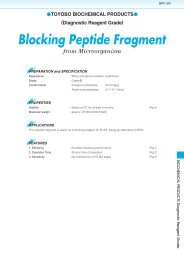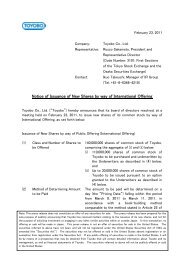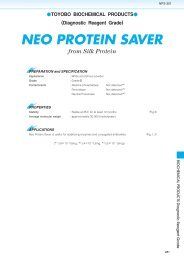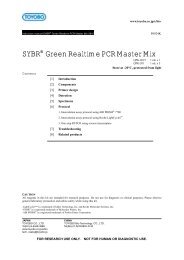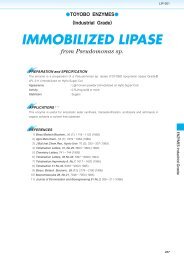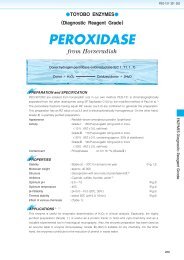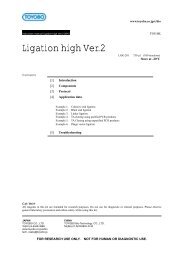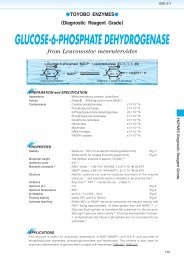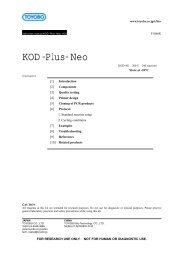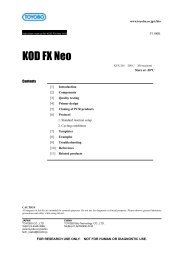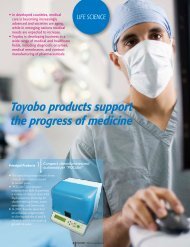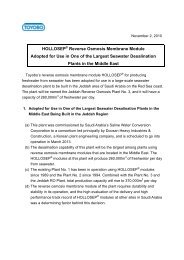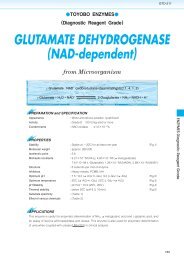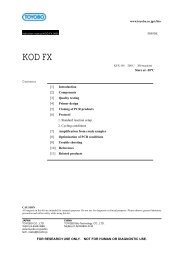Pages (3.2MB) - Toyobo
Pages (3.2MB) - Toyobo
Pages (3.2MB) - Toyobo
Create successful ePaper yourself
Turn your PDF publications into a flip-book with our unique Google optimized e-Paper software.
Ideas + Chemistry<br />
2013<br />
Annual Report<br />
Year ended March 31, 2013
Profile<br />
The <strong>Toyobo</strong> Group aims to become “The category leader, continuing to create new value that contributes<br />
to society in the environment, life science, and high-function products fields.” With its core<br />
technologies of polymerization, modification, processing and biotechnology as its base, <strong>Toyobo</strong> is<br />
expanding its specialty businesses globally, focusing on five markets (Environment, Life science,<br />
Automotive, Electronics & Information Display and Lifestyle & safety) as it works to offer new value<br />
as a high-function products manufacturer.<br />
The Group’s Corporate Philosophy is “Jun-ri-soku-yu.” This phrase was the personal motto of Eiichi<br />
shibusawa, who was the founder of <strong>Toyobo</strong> 130 years ago. It expresses the idea that “Adhering to<br />
Reason Leads to Prosperity.” As we continue to follow this Corporate Philosophy handed down from<br />
the time of its establishment, we will pass the baton to the next generations.<br />
The Group has four main business segments:<br />
• Films and Functional Polymers<br />
• Industrial Materials<br />
• Life Science<br />
• Textiles<br />
Contents<br />
Consolidated Financial Highlights ...............................1<br />
To shareholders and Investors ..................................... 2<br />
New Products ...................................................................... 8<br />
Business segments and Fields ................................... 10<br />
Topics .................................................................................. 12<br />
sustainability ................................................................... 17<br />
Corporate Governance ................................................. 19<br />
Management ................................................................... 20<br />
Investor Information ..................................................... 21<br />
Corporate Data ................................................................ 21<br />
Research and Development ....................................... 15<br />
Caution Regarding Business Forecasts and Forward-Looking Statements<br />
Business forecasts and other forward-looking statements regarding <strong>Toyobo</strong> Co., Ltd. found in this annual report reflect the management’s<br />
assessment based on data available to it at the time that such were compiled. Readers are cautioned that actual business<br />
results may differ materially from these statements due to market trends, economic conditions, and other factors.
Consolidated Financial Highlights<br />
TOYOBO CO., LTD. AND CONsOLIDATED sUBsIDIARIEs<br />
Years ended March 31<br />
Millions of yen<br />
Thousands of U.s.<br />
dollars (Note 1)<br />
2013 2012 2011 2010 2009 2008 2013<br />
Net sales ¥339,009 ¥349,505 ¥340,573 ¥318,773 ¥367,271 ¥431,417 $3,604,561<br />
Films and functional polymers 137,394 138,437 126,960 114,928 122,312 134,631 1,460,861<br />
Industrial materials 71,891 71,221 71,462 63,157 74,656 76,138 764,391<br />
Life science 24,839 26,580 31,386 32,377 33,123 33,961 264,104<br />
Textiles 79,211 87,999 86,832 88,373 111,736 142,471 842,222<br />
Real estate (Note 2) 3,741 3,793 3,602 4,564 4,649 4,267 39,777<br />
Other businesses (Note 2) 21,932 21,474 20,331 15,374 20,795 39,950 233,195<br />
Operating income 17,081 18,305 20,890 11,469 11,229 27,075 181,616<br />
Net income (loss) 7,639 4,587 4,155 2,094 (12,505) 4,698 81,223<br />
EBITDA 30,327 37,778 40,003 31,888 32,435 46,349 322,456<br />
Depreciation and amortization 13,246 19,473 19,113 20,419 21,206 19,274 140,840<br />
Capital expenditure 18,041 16,517 13,931 15,166 20,039 32,486 191,823<br />
R&D expenses 9,966 10,820 10,634 10,296 10,669 10,877 105,965<br />
Total assets 447,445 437,841 443,516 438,439 443,816 494,496 4,757,523<br />
shareholders’ equity (excluding minority interests) 138,024 130,572 125,770 107,095 98,253 129,671 1,467,560<br />
Interest-bearing debt 159,430 154,888 151,804 170,963 178,901 178,842 1,695,162<br />
Net cash flows provided by (used in)<br />
operating activities 30,354 14,192 33,714 29,024 (368) 23,282 322,743<br />
Net cash flows used in investing activities (11,294) (15,061) (11,579) (13,455) (15,803) (10,193) (120,085)<br />
Net cash flows used in financing activities (2,636) (11,531) (9,915) (15,832) 17,379 (17,948) (28,028)<br />
Yen<br />
U.s. dollars<br />
(Note 1)<br />
Per stock data (yen):<br />
Basic net income (loss) per share ¥8.61 ¥5.17 ¥5.49 ¥2.88 (¥17.92) ¥6.73 $0.092<br />
Cash dividends 3.50 3.50 3.50 3.50 3.50 5.00 0.037<br />
Financial ratios:<br />
ROA (%) (Note 3) 3.8 4.2 4.7 2.6 2.5 5.5<br />
ROE (%) 5.7 3.6 3.6 2.0 (11.0) 3.6<br />
Equity ratio (%) 30.8 29.8 28.4 24.4 22.1 26.2<br />
D/E ratio (times) (Note 4) 1.16 1.19 1.21 1.60 1.82 1.38<br />
Notes: 1. The U.s. dollar amounts in this report represent translations of yen for convenience only at the rate of ¥94.05 to $1.00.<br />
2. The real estate leasing business was previously included as part of the Other Businesses segment, but since the value of the assets in this business has exceeded 10% of the total value of<br />
assets in the segment, from the year ended March 31, 2009, the segment classification has been changed to include the Real Estate segment. segment information for the year ended March<br />
31, 2008 has been restated.<br />
3. ROA: Operating income basis.<br />
4. D/E ratio: Interest-bearing debt/net assets excluding minority interests.<br />
Financial Statements, Notes and Independent Auditors’ Report<br />
To view, download them online at www.toyobo-global.com/ir/<br />
TOYOBO 2013 Annual Report 1
To Shareholders<br />
and Investors<br />
Review of<br />
Fiscal 2013<br />
The business environment for the<br />
<strong>Toyobo</strong> Group through the end of<br />
fiscal 2013, ended March 31, 2013,<br />
was characterized by moderate<br />
recovery in the Japanese economy<br />
as reconstruction work progressed<br />
in the wake of the Great East Japan<br />
Earthquake and positive effects<br />
emerged thanks to policies to<br />
revitalize consumer spending. In the<br />
world economy, however, uncertain<br />
Review of Fiscal 2013<br />
conditions continued along with the<br />
slowing of economic growth in<br />
China and the emerging countries<br />
elsewhere in Asia, the prolonged<br />
debt issues faced by some European<br />
governments, and other issues.<br />
Amid this operating environment,<br />
the <strong>Toyobo</strong> Group aims to become<br />
“the category leader, continuing to<br />
create new value that contributes to<br />
society in the environment, life science,<br />
and high-function products<br />
fields.” Accordingly, <strong>Toyobo</strong> is proceeding<br />
with activities targeted at<br />
further expanding its businesses by<br />
developing specialty products and<br />
increasing their sales in domestic<br />
and overseas markets.<br />
However, recovery was in progress in<br />
the fourth quarter, even after factoring<br />
in the effects of lower shipments<br />
in the first quarter, but deterioration<br />
of Japanese-Chinese relations<br />
emerged from the beginning of the<br />
third quarter.<br />
As a result, consolidated net sales<br />
for the subject fiscal year decreased<br />
¥10.5 billion (3.0%) from the previous<br />
fiscal year, to ¥339.0 billion, with<br />
operating income down ¥1.2 billion<br />
(6.7%), to ¥17.1 billion, and net<br />
income rising to ¥7.6 billion.<br />
2 TOYOBO 2013 Annual Report
Ryuzo sakamoto<br />
President & Chief Operating Officer<br />
TOYOBO 2013 Annual Report 3
for Fiscal 2014<br />
Forecast for<br />
Fiscal 2014<br />
During the fiscal year ending March<br />
31, 2014, important developments in<br />
the operating environment are<br />
expected to include further economic<br />
growth in the emerging countries,<br />
including the ASEAN economies, and<br />
moderately strong recovery in the<br />
Japanese economy owing to the<br />
downward correction in the value of<br />
the yen, expansion in government<br />
public works investment, and other<br />
developments. However, the outlook<br />
is for continued uncertainty in the<br />
business environment because of rising<br />
prices of raw materials, concerns<br />
about financial instabilities in<br />
Europe, and other factors.<br />
In view of this outlook for the operating<br />
environment, the <strong>Toyobo</strong> Group<br />
will continue to strengthen its earnings<br />
base to cope successfully with<br />
Medium-Term<br />
changes in the external environment.<br />
The Group works for further<br />
enhancing its profitability by focusing<br />
its management resources on<br />
businesses that are profitable and<br />
have high growth potential, as it<br />
aggressively expands its business<br />
activities in Japan and overseas, and<br />
improving its business portfolio,<br />
such as increasing the efficiency of<br />
its capital, strengthening its financial<br />
position, and other factors.<br />
Considering such factors, for fiscal<br />
2014, the <strong>Toyobo</strong> Group is forecasting<br />
consolidated net sales of ¥350.0<br />
billion (up ¥11.0 billion year on year),<br />
with operating income of ¥22.0 billion<br />
(up ¥4.9 billion), and net income<br />
of ¥9.5 billion (up ¥1.9 billion).<br />
Management<br />
Plan<br />
(Fiscal 2011 to Fiscal 2014)<br />
At present, <strong>Toyobo</strong> is working to<br />
become a “strong company with<br />
growth potential and stable profitability.”<br />
To attain this objective,<br />
<strong>Toyobo</strong> is devoting its resources to<br />
implement the following:<br />
These initiatives to address priority<br />
issues remain unchanged from the<br />
Functional cushion materials<br />
“BREATHAIR”: H1 FY 3/14<br />
Polyester shrinkable film: H1 FY 3/14<br />
Airbag fabrics: H1 FY 3/13<br />
Engineering plastics<br />
Industrial adhesives<br />
VOC* emissions treatment equipment<br />
Filters<br />
* VOC: Volatile Organic Compounds<br />
South Korea/Taiwan<br />
Reverse osmosis (RO) membrane<br />
modules for seawater desalination<br />
H2 FY 3/15<br />
PET films<br />
Industrial adhesives<br />
Diagnostics<br />
Southeast Asia<br />
Industrial adhesives: H2 FY 3/14<br />
Engineering plastics<br />
Airbag fabrics<br />
Diagnostics systems<br />
4 TOYOBO 2013 Annual Report
initial plan, but the operating<br />
environment has become more<br />
challenging than initially expected.<br />
rm Management Plan<br />
Developments causing this situation<br />
have been increases in raw material<br />
and fuel costs, the further appreciation<br />
of the yen, the decline in LCD<br />
sales prices, and other factors. To<br />
cope effectively with these conditions,<br />
the <strong>Toyobo</strong> Group is further<br />
accelerating its overseas business<br />
development and its creation of new<br />
products through its R&D initiatives.<br />
However, in view of trends in the<br />
operating environment, <strong>Toyobo</strong> has<br />
revised its quantitative targets for<br />
fiscal 2014, the final year of the<br />
medium-term management plan.<br />
The recently revised targets as of<br />
May 2012 are ¥350.0 billion in<br />
consolidated net sales (compared<br />
with ¥360.0 billion previously) and<br />
operating income of ¥22.0 billion<br />
(versus the previous target of<br />
¥27.0 billion).<br />
(a) Investments to Expand<br />
Capacity<br />
The <strong>Toyobo</strong> Group is implementing<br />
investments, alliances, and M&A<br />
deals to increase its production<br />
capacity in its specialty businesses<br />
to capture emerging opportunities.<br />
During the fiscal year ended March<br />
31, 2013, investments completed in<br />
the industrial and packaging films<br />
business included multi-functional<br />
polyester film facilities. Also, in contract<br />
manufacturing of pharmaceuticals,<br />
a new plant for production of<br />
injection agents was completed. The<br />
Company will also implement investments<br />
relating to films, fine polymers,<br />
automotive airbag fabrics,<br />
bioproducts, and functional membranes<br />
at the appropriate time.<br />
(b) Acceleration of Overseas<br />
Business Development<br />
The <strong>Toyobo</strong> Group will accelerate the<br />
development of its business activities<br />
in overseas markets that are continuing<br />
to grow, especially in China.<br />
Thus far, the Company’s principal<br />
business has been exporting products<br />
from Japan to overseas markets.<br />
Going forward, however, the<br />
Engineering plastics: H1 FY 3/14<br />
Airbag fabrics: H2 FY 3/13<br />
Filters<br />
Diagnostics<br />
Manufacturing Marketing and sales Office<br />
Overseas Business Development<br />
TOYOBO 2013 Annual Report 5
Company is moving forward to structure<br />
a more-autonomous model for<br />
overseas operations by establishing<br />
and upgrading its business bases<br />
that can conduct integrated overseas<br />
operations, from product development<br />
through to manufacturing and<br />
marketing.<br />
In line with this policy, during fiscal<br />
2013, in the field of automotive airbag<br />
fabrics, the Group began the<br />
production of these fabrics in China<br />
and the United states. In the water<br />
treatment membranes business, the<br />
Group’s reverse osmosis membrane<br />
elements for seawater desalination<br />
were adopted in the largest such<br />
plant in saudi Arabia based on the<br />
Group’s entry into the local market<br />
through a joint venture. In addition,<br />
in the shrinkable film market in<br />
China, where growth is expected<br />
going forward, the Group made a<br />
decision to invest in a joint venture<br />
in China through an alliance with<br />
a film manufacturer based in south<br />
Korea.<br />
Going forward, through alliances<br />
with companies based overseas, the<br />
Group will accelerate the development<br />
of its overseas business<br />
operations.<br />
(c) Improvement<br />
of the Product Portfolio<br />
The activities of the <strong>Toyobo</strong> Group<br />
comprise many specialty businesses.<br />
To build positions of strength in each<br />
of these businesses, we believe it will<br />
be important to continue developing<br />
new products and increasing<br />
value added.<br />
In 2012, <strong>Toyobo</strong> launched three<br />
major new products: “Nerbridge,”<br />
a conduit for regeneration of peripheral<br />
nerves that have been severed<br />
or damaged, an industrial film for<br />
LCDs that has special optical properties,<br />
and a new polyester shrinkable<br />
film for labels that improves productivity<br />
while also being thinner and<br />
stronger. Going forward, we will take<br />
initiatives to improve our product<br />
portfolio by expanding sales of these<br />
newly introduced products and<br />
accelerating work on products<br />
currently under development.<br />
(d) Improving Asset Efficiency<br />
In the textile business, we have<br />
moved ahead without hesitation<br />
with structural reforms that have<br />
involved downsizing and scrapping<br />
of facilities.<br />
Also, among specialty businesses, we<br />
will withdraw from the tire cord business<br />
at the end of December 2013.<br />
Through this and other measures,<br />
we will continue to emphasize asset<br />
efficiency as a major indicator of<br />
management performance.<br />
Operating Income<br />
¥50<br />
billion<br />
Targets<br />
30<br />
20.9<br />
18.3<br />
17.1<br />
22<br />
FY<br />
3/11 3/12 3/13 3/14 (estimate)<br />
3/17 3/21<br />
6 TOYOBO 2013 Annual Report
Looking to<br />
Fiscal 2021<br />
With the aim of being a “strong company<br />
with growth potential and stable<br />
profitability,” <strong>Toyobo</strong> is targeting<br />
net sales of ¥500 billion in fiscal<br />
Looking to Fiscal 2021<br />
2021, operating income of ¥50 billion<br />
(with an ROA of 10%), and a<br />
debt-to-equity ratio of 1.0. Our target<br />
for overseas sales in fiscal 2021 is<br />
¥150 billion, which is about two<br />
times the level in fiscal 2013. In the<br />
environment and life science businesses,<br />
we are aiming for sales of<br />
¥190 billion, or about 3.5 times the<br />
fiscal 2013 level. We believe that our<br />
next medium-term management<br />
plan will be extremely important as<br />
we approach fiscal 2021, and we are<br />
scheduled to begin its formulation in<br />
the latter half of the current fiscal<br />
year.<br />
Return to<br />
Shareholders<br />
<strong>Toyobo</strong> considers providing returns<br />
to shareholders to be one of its highest<br />
priorities. Our basic policy is to<br />
continually provide a stable dividend,<br />
determined in a comprehensive<br />
consideration of such factors as<br />
improving the financial position,<br />
profit levels, and retention of<br />
earnings for future investment.<br />
In accordance with this policy,<br />
<strong>Toyobo</strong> plans to pay a year-end dividend<br />
for the subject fiscal year of<br />
¥3.50 per share. For fiscal 2014, we<br />
expect to pay a dividend of ¥3.50<br />
per share, based on the forecast<br />
net income of ¥9.5 billion.<br />
I would like to offer my sincerest<br />
appreciation to our shareholders and<br />
investors, and ask for your continued<br />
support.<br />
August 2013<br />
Ryuzo sakamoto<br />
President & Chief Operating Officer<br />
TOYOBO 2013 Annual Report 7
New Products<br />
For companies to survive and grow, they must change with the business environment and introduce innovative<br />
products that meet the needs and trends of the times. The key to this is new product development.<br />
In fiscal 2013, <strong>Toyobo</strong> was successful in developing products that are expected to grow in the environment,<br />
life science, and high-function fields.<br />
Examples in the high-function fields include new LCD and optical-use polyester films (super retarder<br />
films). In the environment field, <strong>Toyobo</strong> developed a new shrinkable film for labels, and in the life science<br />
field, a conduit for regenerating damaged peripheral nerves.<br />
These new products are explained below.<br />
Development and Sales Launch<br />
of “Nerbridge” Peripheral Nerve<br />
Regeneration Conduits<br />
<strong>Toyobo</strong> has developed a new medical device, “Nerbridge” (a<br />
conduit for peripheral nerve regeneration), that promotes the<br />
regeneration of nerves that have been damaged by disease<br />
or accidents.<br />
In general, when nerves are damaged by disease or accidents,<br />
patients undergo surgery for autografts or nerve suture.<br />
In the case of autografts, a healthy nerve is extracted from the<br />
patient’s own body and transplanted to the area where nerves<br />
have been injured, but this surgery leaves a scar on the<br />
healthy portion the nerve is removed from, and afterward,<br />
patients may experience pain, numbness, or other side effects.<br />
On the other hand, in the case of nerve suture, the severed<br />
nerves are sewn directly together, but when force is applied to<br />
the affected area, there are cases where the nerves do not heal<br />
and the patient may experience unusual or painful sensations.<br />
To solve the problems with existing treatments, <strong>Toyobo</strong> developed<br />
its “Nerbridge” medical device.<br />
“Nerbridge” conduits are inserted around the damaged portion<br />
of peripheral nerves (nerve gaps) that have been severed<br />
or otherwise damaged and then fastened. Their function is to<br />
induce the portion of the nerve connected to the patient’s central<br />
nervous system to regenerate and grow in the direction of<br />
the portion of the nerve connected to the patient’s peripheral<br />
1cm<br />
nerve endings. In addition, since “Nerbridge” conduits are composed<br />
of polygly colic acid, a new collagen, and other superior<br />
materials that de compose within the body, they dissolve and<br />
are absorbed by the patient’s body in about three months.<br />
Treatment using “Nerbridge” conduits is expected to be equally<br />
effective or more effective (as evidenced by the recovery of<br />
sensation and other attributes) than the previous techniques<br />
of autografts and nerve suture.<br />
For the time being, <strong>Toyobo</strong> is marketing these devices for<br />
use limited to the regeneration of nerves in the hands, including<br />
the fingers. In addition, although <strong>Toyobo</strong> has received<br />
permission from the Ministry of Health, Labour and Welfare<br />
for the manufacturing and marketing of “Nerbridge” for the<br />
regeneration of peripheral nerves (excluding dura mater<br />
nerves, such as those in the brain and spinal cord), <strong>Toyobo</strong> is<br />
scheduled to make cooperative arrangements with medical<br />
institutions, and, when preparations have been completed,<br />
will begin step-by-step expansion beyond the treatment of<br />
the nerves of the hand, including the fingers.<br />
<strong>Toyobo</strong> is aiming for its sales of ¥5.0 billion annually by fiscal<br />
2016.<br />
Development of New Films for LED<br />
and Optical Uses That Overturns the<br />
Conventional Wisdom about Previous<br />
Materials<br />
—Development of Polyester Film That Uses<br />
the Features of LED Light sources to Eliminate<br />
Interference Fringes (“Rainbow mura”*)<br />
<strong>Toyobo</strong> has previously marketed “COsMOsHINE”, an optical<br />
film made with polyester as a raw material, for use as a diffusion<br />
film for liquid crystal displays (LCDs), film for prism lenses,<br />
and film for indium tin oxide films in touch screens.<br />
8 TOYOBO 2013 Annual Report
Conventional PET film (left),<br />
“COSMOSHINE” (SRF type) (right)<br />
In addition, since 2009, <strong>Toyobo</strong> has begun R&D and moved<br />
forward with the development of new films for LED and optical<br />
uses. As the backlight source for LCDs has shifted to LEDs,<br />
<strong>Toyobo</strong> has been successful in developing super retarder film<br />
(sRF) that eliminates the rainbow mura* that formerly could<br />
not be eliminated from existing polyester films. This new film<br />
draws on the film production technology that <strong>Toyobo</strong> has<br />
accumulated in manufacturing “COsMOsHINE” and packaging<br />
films.<br />
“COsMOsHINE” (sRF type) is a new kind of film made possible<br />
by a contrarian concept that overthrows existing common<br />
knowledge that held that materials, other than polarizer<br />
materials, used thus far in LCDs must be isotropic.<br />
Production of this new type of film is possible with the<br />
modification of a portion of equipment currently in use by<br />
<strong>Toyobo</strong> for manufacturing optical films. New investments in<br />
major facilities will be unnecessary. <strong>Toyobo</strong> has already converted<br />
one production line at its Inuyama Plant, one of its<br />
main film production facilities, and switched to mass production.<br />
Output of one production line is approximately 10 million<br />
m 2 /month.<br />
It will be possible to further increase production capacity<br />
in line with market trends. <strong>Toyobo</strong> is aiming for its annual sales<br />
of ¥15.0 billion in 2015.<br />
Features (new functions) of “COSMOSHINE”<br />
(SRF type):<br />
Elimination of coloration (rainbow mura) due to birefringence<br />
Closer conversion of the polarized light given off from LCDs<br />
into more natural light<br />
superior adhesive properties for combining with various<br />
other materials; Principal Uses:<br />
As a protective film for PvA polarizers<br />
various base film materials for touch screens<br />
Improves the visibility of LCDs (usable with polarizing<br />
sunglasses)<br />
Expanding Sales of a New Polyester<br />
Shrinkable Film for Labels<br />
<strong>Toyobo</strong> has sold polyester film for use as shrinkage labels previously,<br />
but <strong>Toyobo</strong> has now developed a new polyester film<br />
for thermal shrinkage labels that responds to customer needs,<br />
such as improvement in perforation properties, thinness, and<br />
greater strength. This new film succeeds in being thinner as it<br />
also improves productivity, and <strong>Toyobo</strong> has set a sales target<br />
in the Japanese market of ¥5.0 billion a year by fiscal 2016.<br />
some of the brands employing this new film are placing<br />
greater emphasis on eco-friendliness, and <strong>Toyobo</strong> has<br />
responded by mixing some resins recycled from PET bottles in<br />
the film.<br />
To gain a foothold in the Chinese market for thermal shrinkable<br />
films, where growth is expected, <strong>Toyobo</strong> has decided to<br />
invest in a Chinese joint venture film company in partnership<br />
with a south Korean-based film manufacturer. <strong>Toyobo</strong> and its<br />
business partners will promote the development of this new,<br />
more eco-friendly film as a replacement for polyvinyl chloride<br />
(PvC), which is currently used for shrinkable films in China.<br />
* “Rainbow mura” is a phenomenon in which color unevenness, similar to that of a rainbow,<br />
appears, because of the birefringence of the material.<br />
Installation of New<br />
Polyester Film<br />
Manufacturing<br />
Equipment<br />
<strong>Toyobo</strong>’s film business is divided into<br />
industrial films and packaging films.<br />
Previously, these two types were produced<br />
by using dedicated equipment<br />
for each type. This time, however,<br />
<strong>Toyobo</strong> will install multi-function film<br />
manufacturing equipment for producing<br />
both industrial and packaging<br />
polyester films at its Tsuruga film plant<br />
(located in Tsuruga City, Fukui<br />
Prefecture). The amount of this investment<br />
will be approximately ¥10 billion,<br />
and one line of this new equipment will<br />
have a production capacity of 22,000<br />
tons per year. Production will be started<br />
up in October 2013.<br />
As a result of this investment, it will be<br />
possible to increase the efficiency of<br />
overall film production. In the industrial<br />
film business, this new equipment will<br />
be used for manufacturing films for the<br />
increasingly broad range of new uses. In<br />
addition, in the packaging film business,<br />
<strong>Toyobo</strong> will create a more competitive<br />
production system and plans to work<br />
to maintain its position as the No. 1<br />
supplier in the Japanese market.<br />
TOYOBO 2013 Annual Report 9
At a Glance<br />
Business Segments and Fields<br />
Films & Functional Polymers<br />
Percentage of<br />
Net Sales<br />
41%<br />
Sales<br />
(¥ billion)<br />
135<br />
122<br />
115<br />
Industrial Materials<br />
Percentage of<br />
Net Sales<br />
21%<br />
127<br />
138<br />
137<br />
Operating Income<br />
(¥ billion)<br />
’08 ’09 ’10 ’11 ’12 ’13 ’08 ’09 ’10 ’11 ’12 ’13<br />
Sales<br />
(¥ billion)<br />
76<br />
75<br />
63<br />
71<br />
71<br />
72<br />
13.7<br />
4.3<br />
6.1<br />
12.5<br />
Operating Income<br />
(¥ billion)<br />
’08 ’09 ’10 ’11 ’12 ’13 ’08 ’09 ’10 ’11 ’12 ’13<br />
5.5<br />
4.1<br />
2.3<br />
4.9<br />
8.6<br />
5.3<br />
7.6<br />
5.5<br />
Industrial films<br />
• PET films for (i) FPD use, (ii) photovoltaic backsheets, (iii) touch<br />
screens, (iv) ceramic capacitor process sheets, and (v) other<br />
industrial uses<br />
• Synthetic paper<br />
Packaging films<br />
• PET, polyolefin, polyamide for food packaging, and shrinkable<br />
films for labels<br />
Functional polymers<br />
• Engineering plastics<br />
• For industrial adhesives, coatings: co-polyester, and modified<br />
polyolefin<br />
• Acrylate polymers<br />
Functional fibers<br />
• Airbag fabrics, polyester yarn for tire cord<br />
High-performance fibers<br />
• Ultra-high-strength polyethylene fiber<br />
• PBO fiber: extreme heat-resistant, high-tenacity fiber<br />
Functional filters, non-woven fabrics<br />
• Filters for (i) automotive components, (ii) office equipment, and<br />
(iii) air purifiers<br />
• VOC emissions treatment equipment and systems with activated<br />
carbon filters<br />
• Non-woven fabrics for automotive parts and construction<br />
materials<br />
Life Science<br />
Percentage of<br />
Net Sales<br />
7%<br />
Sales<br />
Operating Income<br />
(¥ billion)<br />
(¥ billion)<br />
34<br />
33<br />
32<br />
31<br />
27<br />
25<br />
5.1<br />
3.0<br />
4.0<br />
3.7<br />
4.1<br />
4.2<br />
’08 ’09 ’10 ’11 ’12 ’13 ’08 ’09 ’10 ’11 ’12 ’13<br />
Bioproducts<br />
• Enzymes for diagnostics, diagnostic systems and reagents,<br />
research reagents, and cosmetic ingredients<br />
Pharmaceuticals<br />
• Contract manufacturing (injections, raw pharmaceuticals, and<br />
antibody drugs)<br />
Medical membranes, equipment, and devices<br />
• Hollow fiber membranes for artificial kidneys, and anti-clotting<br />
materials<br />
• Medical treatment devices<br />
Water treatment membranes<br />
• Reverse osmosis membranes for seawater desalination<br />
• Ultra-filtration membranes for drinking water<br />
Textiles<br />
Percentage of<br />
Net Sales<br />
Sales<br />
(¥ billion)<br />
142<br />
Operating Income<br />
(¥ billion)<br />
3.8<br />
Textiles<br />
• Functional textiles<br />
23%<br />
112<br />
88<br />
87<br />
88<br />
79<br />
1.4<br />
Apparel products<br />
• “Munsingwear”: sportswear<br />
Acrylic fibers<br />
• “EXLAN”: acrylic fibers<br />
1.1<br />
0.4<br />
0.6<br />
0.2<br />
’08 ’09 ’10 ’11 ’12 ’13 ’08 ’09 ’10 ’11 ’12 ’13<br />
10 TOYOBO 2013 Annual Report
Automotive<br />
Electronics<br />
&<br />
Information Displays<br />
Environment Life Science Lifestyle & Safety<br />
Engineering plastics<br />
PET films for<br />
optical uses<br />
Materials for photovoltaic<br />
systems<br />
Packaging films<br />
Biomass high-melting-point polyamide<br />
for molding<br />
Co-polyester adhesives<br />
Modified polyolefin adhesives<br />
Acrylate polymers<br />
Airbag fabrics<br />
Functional filters<br />
Non-woven fabrics<br />
New catalyst for<br />
polyester<br />
VOC emissions<br />
treatment equipment<br />
and systems<br />
Functional filters<br />
High-performance<br />
fibers<br />
Three-dimensional<br />
spring-structured<br />
fibers<br />
Water treatment<br />
membranes<br />
Medical membranes<br />
Enzymes for diagnostics<br />
Diagnostic systems<br />
and reagents<br />
Cosmetics ingredients<br />
Medical treatment<br />
devices<br />
Pharmaceuticals<br />
(contract manufacturing)<br />
Functional textiles<br />
TOYOBO 2013 Annual Report 11
TOPICS<br />
Capital Investment<br />
Expansion in Injection<br />
Production Facilities in<br />
Contract Manufacturing<br />
of Pharmaceuticals<br />
1<br />
In its contract manufacturing of<br />
pharmaceuticals, <strong>Toyobo</strong> produces<br />
not only ethical drugs prescribed by<br />
hospitals but also drugs in the clinical<br />
testing stage that are under<br />
development. At present, the market<br />
for contract manufacturing is<br />
expanding at between 5% and 10%<br />
annually, and the estimated market<br />
size in Japan alone in 2013 was<br />
about ¥600 billion. <strong>Toyobo</strong><br />
has established a strong reputation<br />
in the pharmaceutical industry<br />
for its capabilities in producing<br />
biopharmaceuticals, and its technology<br />
has been evaluated highly. For<br />
these and other reasons, <strong>Toyobo</strong><br />
receives many contracts for the production<br />
of biopharmaceuticals,<br />
which are more difficult to manufacture<br />
than low-molecular drugs, from<br />
the development stage.<br />
In March 2013, <strong>Toyobo</strong> began<br />
production at its new injection line.<br />
The new facility secures a highly<br />
bacteria-free production environment<br />
by featuring (a) an enclosed<br />
sterilizable space called “RABs (Re-<br />
stricted Access Barrier system)” and<br />
(b) an intensive usage of single-use<br />
operating procedures. Other capabilities<br />
of the new production line<br />
include production of many items<br />
in small lots and the ability to meet<br />
the Good Manufacturing Practices<br />
(GMP) of the three major markets:<br />
Japan, North America, and Europe.<br />
We will aim for full capacity operation<br />
during 2013.<br />
Looking ahead, drawing on its<br />
sophisticated technological capabilities,<br />
<strong>Toyobo</strong> will continue to expand<br />
its high-value-added contract manufacturing<br />
of antibiotic drugs and<br />
other special pharmaceuticals and<br />
2<br />
new drugs that require advanced<br />
production technology.<br />
Entry into the Airbag<br />
Business in North America<br />
Thus far, <strong>Toyobo</strong> has manufactured<br />
airbag fabrics in Japan, Thailand,<br />
and China, selling principally to<br />
Japanese-related automotive<br />
manufacturers. In recent years, as<br />
Japanese automotive companies<br />
have increased local production<br />
overseas, they have also proceeded<br />
with procurement of parts and<br />
materials in the local markets. In<br />
addition, with the growth of the<br />
BRICs and other emerging country<br />
markets and the tightening of legal<br />
regulations in the United states, the<br />
demand for airbags has expanded<br />
worldwide.<br />
Amid these developments,<br />
<strong>Toyobo</strong> has worked to expand its<br />
airbag business and decided to<br />
establish an airbag fabric sales company<br />
in the United states. since the<br />
establishment of this company in<br />
April 2012, it has moved forward to<br />
obtain certifications from local automotive<br />
parts manufacturers and is<br />
scheduled to begin full-scale sales<br />
activities in summer 2013.<br />
The total expenditures on establishing<br />
this sales infrastructure were<br />
approximately ¥1 billion. <strong>Toyobo</strong>’s<br />
airbag business, in addition to operations<br />
in Japan and Thailand, went<br />
into full-scale manufacturing and<br />
with sales operations in China in<br />
April 2012. In addition to the North<br />
American operations, <strong>Toyobo</strong> will<br />
aim to structure a global supply<br />
system.<br />
12 TOYOBO 2013 Annual Report
2<br />
1<br />
3<br />
Manufacturing and Sales<br />
Company for “VYLON”<br />
Established in Thailand<br />
<strong>Toyobo</strong> has manufactured “vYLON”<br />
co-polyester resin and continues to<br />
do so in Japan, selling it mainly to<br />
customers in the IT products and<br />
other electronics industries. In<br />
recent years, the number of<br />
Japanese companies setting up<br />
operations in China, the countries of<br />
AsEAN, India, and elsewhere as well<br />
as the number of European and U.s.<br />
companies shifting production to<br />
these countries has grown, and local<br />
companies overseas have also<br />
entered the electronics markets.<br />
Moreover, these countries are<br />
expected to show sustainable<br />
growth going forward.<br />
In view of these prospects, to<br />
expand sales of “vYLON” into the<br />
electronics-related markets, <strong>Toyobo</strong><br />
decided to establish a joint venture<br />
for the manufacturing and sale<br />
of “vYLON” in partnership with<br />
Mitsubishi Corporation in Thailand,<br />
a country that offers favorable tax<br />
treatment, highly convenient logistics,<br />
and other advantages. <strong>Toyobo</strong><br />
will be in charge of production<br />
management and technical support,<br />
and Mitsubishi Corporation will<br />
draw on its extensive business experience<br />
in Thailand and cooperate in<br />
the material procurement and product<br />
marketing.<br />
The joint venture was established<br />
in July 2012. Production will begin<br />
in January 2014 and reach full<br />
capacity in 2016. The newly established<br />
company is scheduled to be<br />
<strong>Toyobo</strong>’s base for business operations<br />
in the Chinese, Indian, and<br />
AsEAN markets, and it will work to<br />
expand sales.<br />
Overseas Expansion<br />
4<br />
Shipments Begin to<br />
the World’s Largest<br />
Seawater Desalination<br />
Plant<br />
<strong>Toyobo</strong>’s “Hollosep” reverse osmosis<br />
membrane elements for seawater<br />
desalination have been selected for<br />
use in the Ras Al Khair Plant in saudi<br />
Arabia, which is the largest<br />
seawater desalination<br />
facility in the world.<br />
shipments began<br />
in March 2013 in<br />
preparation for the<br />
3 4<br />
commencement of operations in<br />
2014. This plant will use <strong>Toyobo</strong>’s<br />
reverse osmosis membrane elements<br />
and will produce 345,000<br />
cubic meters of water per day.<br />
In addition, production has<br />
begun of “Hollosep” reverse osmosis<br />
membrane elements for seawater<br />
desalination at the Arabian<br />
Japanese Membrane Company, LLC<br />
(AJMC) in saudi Arabia, which is a<br />
three- company joint venture with<br />
ACWA Holding of saudi Arabia and<br />
ITOCHU Corporation.<br />
<strong>Toyobo</strong> is planning to make<br />
AJMC a base for expansion of this<br />
business in Middle Eastern seawater<br />
desalination, where further growth<br />
is expected in the years ahead.<br />
<strong>Toyobo</strong> is planning to expand sales<br />
of reverse osmosis membrane<br />
elements for seawater<br />
desalination<br />
broadly,<br />
4 4<br />
TOYOBO 2013 Annual Report 13
TOPICS<br />
not only in saudi Arabia, but also in<br />
the other countries of the Middle<br />
East and North Africa.<br />
Operations in Indonesia<br />
In its sports apparel business,<br />
<strong>Toyobo</strong> makes use of high-value-<br />
added specialized materials.<br />
To differentiate itself from other<br />
5 6<br />
users. To respond to expanding<br />
5<br />
6<br />
market needs, TKI and sTG are<br />
increasing production capacity.<br />
Market Development for<br />
3D Fiber “BREATHAIR”<br />
in Europe<br />
“BREATHAIR” is a three-dimensional<br />
spring-structured fiber created by<br />
use of <strong>Toyobo</strong>’s “PELPRENE,” which is<br />
companies, <strong>Toyobo</strong> is producing<br />
a polyester elastomer. It is in wide<br />
high-quality materials in Indonesia, use as a cushion material that<br />
where operations are highly cost<br />
replaces urethane foam.<br />
competitive.<br />
Responding to the increasing<br />
At present, <strong>Toyobo</strong>’s operations<br />
market demand for this fiber in<br />
in Indonesia include two manufacturing<br />
subsidiaries, P.T. TOYOBO<br />
(headquartered in Dusseldorf) will<br />
Europe, TOYOBO Europe GmbH<br />
KNITTING INDONEsIA (TKI), which<br />
begin the further development,<br />
is engaged in knitting and dyeing<br />
manufacturing, and sales of<br />
activities, and P.T. sHINKO TOYOBO “BREATHAIR” in Europe. To do this,<br />
GIsTEX (sTG), which engages in<br />
<strong>Toyobo</strong> is making about ¥700 million<br />
in capital investments in<br />
sewing operations.<br />
TKI uses materials that it procures Germany to construct a manufacturing<br />
facility with an annual capacity<br />
locally and produces fabrics, which<br />
are developed and planned in<br />
of 1,100 tons, which is scheduled to<br />
Japan, to Japanese quality standards.<br />
sTG uses the fabric manufac-<br />
Looking ahead, <strong>Toyobo</strong> will further<br />
go into operation in August 2013.<br />
tured by TKI to make sports apparel. increase the sales of “BREATHAIR” in<br />
The sports apparel produced by<br />
Europe for such applications as furniture<br />
as it also develops new uses<br />
TKI and sTG is sold not only in Japan<br />
but around the world. since these<br />
such as mattresses for medical use<br />
production arrangements offer<br />
and seats for boats, automobiles,<br />
advantages to customers, enabling and trains.<br />
them to purchase products that<br />
<strong>Toyobo</strong> began mass production of<br />
meet Japanese quality standards<br />
“BREATHAIR” in 1996. It has earned a<br />
at low prices, the products have<br />
strong reputation as a superior<br />
earned a high appraisal among<br />
cushion material and has been<br />
adopted for use in the seats of<br />
trains, especially the N700 series of<br />
shinkansen trains, motorcycles, and<br />
other applications.<br />
Continued Evolution<br />
in the Bio-Businesses<br />
7<br />
During the 1990s, <strong>Toyobo</strong> has been<br />
reinforcing its commitment in sMBG<br />
(self-Monitoring of Blood Glucose)<br />
business, offering material enzymes<br />
used for glucose sensors. Thereafter,<br />
through a few renewals in the<br />
enzyme properties using gene<br />
recombinant technologies, <strong>Toyobo</strong><br />
launched in 2009 “FAD-GDH,” the<br />
latest version that enables even<br />
more-accurate glucose measurement.<br />
At present, <strong>Toyobo</strong> has the second-largest<br />
global market share in<br />
the enzyme business for diagnostic<br />
use.<br />
Making full advantage of<br />
micro-organism fermentation and<br />
purification technologies it has been<br />
accumulating over the decades in<br />
enzyme business operations,<br />
<strong>Toyobo</strong> is expanding further into<br />
diagnostic systems, materials for<br />
cosmetics, and other fields.<br />
7<br />
14 TOYOBO 2013 Annual Report
Research<br />
and Development<br />
<strong>Toyobo</strong> began its operations in 1882 as a textile company,<br />
but from that time to the present, <strong>Toyobo</strong> has made<br />
transitions into new businesses after taking account of<br />
social conditions and requirements as well as the business<br />
environment. Today, <strong>Toyobo</strong> positions films, functional<br />
polymers, industrial materials, and life science as<br />
its core businesses, or specialty businesses, and is aiming<br />
to grow and develop as “the category leader, continuing<br />
to create new value that contributes to society<br />
in the environment, life science, and high-function<br />
products fields.”<br />
Through making transitions into new businesses,<br />
<strong>Toyobo</strong> has introduced and acquired a wide range of<br />
technologies. Among these, <strong>Toyobo</strong> places polymerization,<br />
modification, processing, and biotechnology as its<br />
core technologies. Through further in-depth research on<br />
and combining of these core technologies, <strong>Toyobo</strong> has<br />
developed high-function products in the environmental<br />
and life science fields and proceeded with the nurturing<br />
of new businesses. <strong>Toyobo</strong> works to accelerate its R&D<br />
activities by partic ipating in Japan’s national projects, by<br />
advancing aggressively into alliances with academia<br />
and industry in Japan and overseas as well as by conducting<br />
joint research with other companies in<br />
advanced fields in the environmental and energy areas.<br />
At the same time, <strong>Toyobo</strong> is substantially expanding<br />
its business activities in overseas markets, and in its R&D<br />
also, to understand the needs of local markets, gather<br />
information, and respond quickly to customer needs,<br />
<strong>Toyobo</strong> is strengthening its teamwork with its overseas<br />
subsidiaries and offices and establishing local technology<br />
centers.<br />
TOYOBO 2013 Annual Report 15
Intellectual Property<br />
Strategy<br />
The <strong>Toyobo</strong> Group works to secure patent protection<br />
for the vast accumulation of inventions that have been<br />
made over many years of research and development.<br />
At the same time, to sustain and further develop its<br />
business activities, <strong>Toyobo</strong> has established systems<br />
for responding quickly to the patent-related activities<br />
of other companies, including competitors.<br />
In recent years, as intellectual property functions<br />
have received increased attention, <strong>Toyobo</strong> has worked<br />
to give these activities a strategic orientation. For example,<br />
<strong>Toyobo</strong> has created intellectual property databases<br />
and used these for analytical studies, which are then<br />
applied to assist in the commercialization of <strong>Toyobo</strong>’s<br />
own products and for keeping track of industry trends.<br />
In addition, along with the globalization of business<br />
activities, <strong>Toyobo</strong> has formulated and implemented<br />
overseas intellectual property strategies.<br />
<strong>Toyobo</strong>’s Intellectual Property Operating Office works<br />
with the personnel responsible for intellectual property<br />
related liaison who have been appointed by the business<br />
divisions, R&D Division, and other divisions to convene<br />
patent review meetings appropriate to the stage<br />
of development of various R&D projects as well as intellectual<br />
property strategy meetings. Through these intellectual<br />
property related activities, the office conducts<br />
research and analyses, applies for patents, and upholds<br />
the Company’s rights in close coordination with the<br />
<strong>Toyobo</strong> Group’s corporate strategies and R&D strategies.<br />
“XENOMAX” High Heat-<br />
Resistant Polyimide Film<br />
One of the materials that <strong>Toyobo</strong> has conducted R&D<br />
on for many years is “XENOMAX,” a polyimide film that<br />
has the same level of dimensional stability over a wide<br />
thermal range as silicon used in semiconductors, high<br />
heat resistance, and excellent flame retardance.<br />
“XENOMAX” has the same low linear expansion<br />
coefficient as silicon over a wide temperature range,<br />
from -50 to 450 degrees centigrade. Moreover, this<br />
product has a decomposition temperature of over 500<br />
degrees centigrade, which is the highest of any organic<br />
polymer film, and even in a 450-degree environment,<br />
it shows almost no change in shape. Also,<br />
because of its molecular structure, “XENOMAX” is<br />
resistant to combustion and has been certified as the<br />
thinnest polymer film that does not contain any halogen<br />
compound under the UL Certification System, an<br />
international indicator of resistance to combustion.<br />
In view of these properties, <strong>Toyobo</strong> is aiming to<br />
enter the market for next-generation electronic materials.<br />
In displays and high-performance electronic<br />
devices, inorganic materials, such as ceramics and<br />
glass, are used as the substrates in semiconductor<br />
devices because they have properties close to silicon.<br />
However, since these inorganic materials tend to be<br />
thick, heavy, and easily broken, thinner and lighter<br />
polymer films are taking their places, thus enabling<br />
manufacturers to raise the specifications of portable<br />
electronic devices, including making them more compact<br />
and lighter. At present, <strong>Toyobo</strong> is proceeding<br />
with development jointly with a number of electronic<br />
device manufacturers, and its products are expected<br />
to be adopted in the manufacturing of the compact,<br />
light electronic device materials and light, flexible<br />
display substrate materials that are indispensable<br />
in tomorrow’s advanced information society.<br />
Research<br />
and Development<br />
16 TOYOBO 2013 Annual Report
Sustainability/<br />
Corporate Governance<br />
Becoming a “Strong Company<br />
with Growth Potential and<br />
Stable Profitability”<br />
As the <strong>Toyobo</strong> Group looks to the year 2020, it is aiming to<br />
be “the category leader, continuing to create new value<br />
that contributes to society in the environment, life science,<br />
and high-function products fields.” The Group believes that<br />
corporate activities, business activities, and CsR activities<br />
should all be integrated. What is important is to implement<br />
activities to deal with changes in the operating environment<br />
and among stakeholders.<br />
Recently, changes in the external environment have<br />
been very rapid. These have included fluctuations in the<br />
prices of petroleum-based materials, changes in foreign<br />
exchange rates, the rise in the inflow of products from<br />
overseas, and changes in consumer behavior. Corporations<br />
must have a strong driving power to expand their business<br />
activities to respond to these changes.<br />
To measure up to the challenge, the <strong>Toyobo</strong> Group wants<br />
to become a “strong company with growth potential and<br />
stable profitability” as well as a company that contributes<br />
to societies around the world through its business activities,<br />
accelerates its expansion into overseas markets, and<br />
continues to develop new technologies and products.<br />
Contributing to a Sound and<br />
Sustainable Society with the<br />
Awareness That Companies<br />
Are Members of Society<br />
To implement CsR activities, <strong>Toyobo</strong> has established its CsR<br />
Committee, which is chaired by the president. The mission<br />
of this committee is to fully comprehend and monitor overall<br />
activities related to all stakeholders, including shareholders<br />
and investors, suppliers, the community,<br />
employees, and the earth’s environment.<br />
The basis for these activities is <strong>Toyobo</strong>’s CsR Charter,<br />
which states the awareness of <strong>Toyobo</strong> that “companies are<br />
members of society” and clearly calls for the <strong>Toyobo</strong> Group<br />
to actively fulfill its social responsibilities and contribute to<br />
the creation of a sound and sustainable society.<br />
some of the CsR initiatives being implemented by the<br />
<strong>Toyobo</strong> Group include the following. First, <strong>Toyobo</strong> has put<br />
in place a corporate governance system that enhances<br />
checking and monitoring functions and raises the transparency<br />
of decision making and the execution of business<br />
activities. In addition, to create a compliance framework<br />
and raise awareness among employees of the necessity to<br />
maintain high standards of compliance with laws and regulations,<br />
<strong>Toyobo</strong> has issued a Compliance Manual containing<br />
the <strong>Toyobo</strong> Group Employee Guidelines for Action, which<br />
serves as the code of conduct. Moreover, the <strong>Toyobo</strong> Group<br />
conducts compliance training not only in Japan but also in<br />
Group companies overseas.<br />
TOYOBO 2013 Annual Report 17
Regarding risk management, each of the committees<br />
is developing systems that can effectively cope with risks.<br />
To deal with environmental issues, based on its “Basic<br />
Environmental Policy,” <strong>Toyobo</strong> is working to reduce the<br />
burden that its activities place on the natural environment,<br />
develop products that contribute to protecting the eco-<br />
ustainability/<br />
Nurturing Global<br />
sphere, conduct environmental preservation activities in<br />
the community, and respond affirmatively to biodiversity.<br />
Human Resources<br />
To strengthen the capabilities of its personnel to work in<br />
international assignments in various countries and regions,<br />
the <strong>Toyobo</strong> Group is conducting education and training<br />
programs for employees in Japan and the staff of its overseas<br />
subsidiaries.<br />
For personnel in Japan, <strong>Toyobo</strong> has created its “shortterm<br />
overseas training program.” Under this program,<br />
Japanese employees are stationed for about a year at<br />
<strong>Toyobo</strong>’s overseas subsidiaries, other Group companies, or<br />
on the properties of business partner companies where<br />
they are given a specific mission that is directly related to<br />
<strong>Toyobo</strong>’s business.<br />
For staff employed by <strong>Toyobo</strong>’s overseas subsidiaries,<br />
arrangements are made for them to hold discussions with<br />
Japanese staff who are candidates for managerial positions.<br />
Through these opportunities for interchange and<br />
friendly rivalry, <strong>Toyobo</strong> is working to raise their sense of<br />
belonging to the <strong>Toyobo</strong> organization and strengthen their<br />
motivation.<br />
Green Procurement<br />
<strong>Toyobo</strong> is taking initiatives to protect the natural environment<br />
through its products and manufacturing activities.<br />
<strong>Toyobo</strong> places priority on procuring raw materials that<br />
have a minimum impact on the environment and strives to<br />
contribute to creating a sustainable society. As part of<br />
these activities, <strong>Toyobo</strong> pursues “green procurement” policies.<br />
<strong>Toyobo</strong> requests its business partners to supply information<br />
on the chemical substance content of the raw<br />
materials they use to ensure: (1) that none of the substances<br />
forbidden by <strong>Toyobo</strong> regulations are contained in the<br />
G Corporate<br />
products they supply and (2) that the amounts of harmful<br />
substances specified by <strong>Toyobo</strong> are indicated.<br />
In addition, for other items in general, <strong>Toyobo</strong> promotes<br />
the green procurement of products that bear the<br />
“Environment Label.”<br />
Initiatives to Reduce the<br />
Burden on the Environment<br />
To protect the air and water, the <strong>Toyobo</strong> Group promotes<br />
reduction in the volume of its emissions. To reduce the<br />
environmental burden of emissions into the atmosphere,<br />
<strong>Toyobo</strong> has made the transition from the use of heavy fuel<br />
oil to LNG as the energy source in its boilers. In addition, to<br />
lower the environmental impact of effluent emissions into<br />
bodies of water, <strong>Toyobo</strong> has upgraded the capabilities of its<br />
waste treatment facilities and promoted the treatment of<br />
effluence that may have a particularly significant adverse<br />
impact on the environment as industrial waste.<br />
Trends in Incidence Ratios in the <strong>Toyobo</strong> Group<br />
(%)<br />
1.5<br />
1.0<br />
Average for manufacturing<br />
in Japan<br />
<strong>Toyobo</strong> Group<br />
0.5<br />
0<br />
FY<br />
’08<br />
’09<br />
’10<br />
<strong>Toyobo</strong><br />
(nonconsolidated)<br />
’11<br />
’12<br />
’13<br />
Note: Incidence ratios are the number of<br />
cases where employees had to take<br />
leave due to accidents per one million<br />
hours worked. Employees include<br />
those working for the <strong>Toyobo</strong> Group<br />
and its subcontractors. The incidence<br />
ratio is computed each year on a<br />
calendar-year basis.<br />
18 TOYOBO 2013 Annual Report
Also, <strong>Toyobo</strong> has worked to reduce the volume of water<br />
used for and wastewater emissions from chillers as well as<br />
effluent emissions through the supervision of water usage<br />
in manufacturing processes and other measures.<br />
Labor Safety and Health<br />
<strong>Toyobo</strong>’s basic stance is that “ensuring safety is a major<br />
prerequisite for the conduct of corporate activities” and<br />
has, therefore, worked toward the goal of zero accidents.<br />
<strong>Toyobo</strong>’s safety management systems are based around<br />
its safety and security Promotion Committee. In addition,<br />
the <strong>Toyobo</strong> Group Environmental safety Committee is<br />
responsible for implementing safety measures.<br />
<strong>Toyobo</strong> (on a nonconsolidated basis) achieved zero lost<br />
time due to injuries caused by human error during the fiscal<br />
year under review. However, there were six incidents of<br />
lost time due to accidents among other <strong>Toyobo</strong> Group<br />
companies. The Group as a whole is continuing to aim for<br />
zero lost time due to accidents.<br />
The <strong>Toyobo</strong> Group has newly prepared and is implementing<br />
a medium-term management plan for preventing<br />
labor accidents that covers the period from FY2012<br />
through FY2016. In addition to attaining the objective of<br />
zero lost time due to accidents, the Group has also set a<br />
goal of 20 or fewer accidents per year that do not result in<br />
lost time.<br />
overnance<br />
Corporate Governance<br />
Board of Directors<br />
and Executive Officers<br />
<strong>Toyobo</strong> is a “Company with Auditors” as defined by<br />
Japan’s Companies Act and, under this governance system,<br />
has appointed one outside director and adopted<br />
the Executive Officer System. Under <strong>Toyobo</strong>’s governance<br />
framework, a clear distinction is made between<br />
the roles of the Board of Directors, who concentrate on<br />
decision making as they perform management oversight<br />
functions, and the executives, who are in charge<br />
of business execution. This corporate governance<br />
system increases the transparency and fairness of<br />
management and makes it possible to make prompt<br />
decisions as well as conduct business efficiently.<br />
The Board of Directors has nine members, one of<br />
whom is an outside director, whose role is to ensure<br />
transparency and fairness in <strong>Toyobo</strong>’s management. In<br />
addition, in view of the diverse and specialized nature<br />
of <strong>Toyobo</strong>’s businesses, and to make decisions accurately<br />
and quickly, the eight members of the Board of<br />
Directors, after exclusion of the outside director, also<br />
hold positions as Executive Officers.<br />
Regarding “business execution,” the President and<br />
Chief Executive Officer call meetings of the Board of<br />
Corporate Executive Officers and the Board of<br />
Corporate Officers. These committees make decisions<br />
regarding the items for business execution assigned to<br />
them by the Board of Directors, make reports on companywide<br />
projects, and perform certain other duties.<br />
Corporate Auditor System<br />
The Board of Auditors has four members, two of whom<br />
are Outside Auditors. Their responsibilities include<br />
attending meetings of the Board of Directors and other<br />
important meetings, stating their opinions as necessary,<br />
and auditing the performance of duties by the<br />
Board of Directors based on audits of operations in the<br />
various divisions. KPMG AZSA LLC has been appointed<br />
to conduct the independent audits required under<br />
Japan’s Corporation Law. The Board of Auditors<br />
receives plans for auditing and audit reports from the<br />
independent auditor and meets with the independent<br />
auditor periodically to exchange information.<br />
For further details:<br />
To view, download them online at www.toyobo-global.com/company/governance/<br />
TOYOBO 2013 Annual Report 19
Management<br />
As of June 27, 2013<br />
Board of Directors<br />
President<br />
Ryuzo Sakamoto<br />
Hiroshi<br />
Takahashi<br />
Kazumasa<br />
Koyama<br />
Hiroshi<br />
Takabayashi<br />
Seiji<br />
Narahara<br />
Toshiyuki<br />
Matsui<br />
Kunio<br />
Yano<br />
Shigeki<br />
Sano<br />
Michio<br />
Ogimura*<br />
* Outside Director<br />
Board of Corporate Auditors<br />
Setsuo Shimomichi<br />
Morito Morita<br />
Hiroshi Imanaka**<br />
Akio Ukai**<br />
** Outside Corporate Auditor<br />
Corporate Officers<br />
Chief Operating Officer<br />
Ryuzo Sakamoto<br />
Corporate Executive Officers<br />
Hiroshi Takahashi<br />
Kazumasa Koyama<br />
Hiroshi Takabayashi<br />
Shinichi Onizuka<br />
Corporate Officers<br />
Seiji Narahara<br />
Toshiyuki Matsui<br />
Kunio Yano<br />
Shigeki Sano<br />
Hisao Nishinaka<br />
Toshitake Suzuki<br />
Hiroyuki Sato<br />
Jiro Suwa<br />
Shinichi Teshima<br />
Yuji Oita<br />
Masakazu Saito<br />
Teruo Ohigashi<br />
Hitoshi Ueno<br />
Shigeo Takenaka<br />
20 TOYOBO 2013 Annual Report
Investor Information<br />
As of March 31, 2013<br />
Stock Listing<br />
Tokyo<br />
Stock Code<br />
3101<br />
Transfer Agent<br />
Sumitomo Mitsui Trust Bank, Ltd.<br />
1-4-1, Marunouchi, Chiyoda-ku,<br />
Tokyo 100-8233, Japan<br />
Independent Auditors<br />
KPMG AZSA LLC<br />
3-6-5, Kawara-machi, Chuo-ku,<br />
Osaka 541-0048, Japan<br />
Common Stock<br />
Authorized: 2,000,000,000 shares<br />
Issued: 890,487,922 shares<br />
Paid-in Capital<br />
¥51,730 million<br />
Number of Stockholders<br />
104,131<br />
Major Shareholders<br />
Number of shares<br />
held (thousands)<br />
Percentage of<br />
voting rights (%)<br />
Japan Trustee Services Bank, Ltd. (Trust Account) 46,586 5.24<br />
The Master Trust Bank of Japan, Ltd. (Trust Account) 27,368 3.08<br />
Nippon Life Insurance Company 21,885 2.46<br />
Toyukai (Contractor Share Holding) 16,485 1.86<br />
Mizuho Corporate Bank, Ltd. 13,393 1.51<br />
<strong>Toyobo</strong> Employee Stockholders’ Association 13,260 1.49<br />
The Bank of Tokyo–Mitsubishi UFJ, Ltd. 13,214 1.49<br />
Sumitomo Mitsui Banking Corporation 13,034 1.47<br />
Meiji Yasuda Life Insurance Company 11,029 1.24<br />
Japan Trustee Services Bank, Ltd. (Account of Retirement<br />
Benefit Trust for Sumitomo Mitsui Trust Bank, Limited) 9,054 1.02<br />
Corporate Data<br />
As of March 31, 2013<br />
Head Office<br />
2-8, Dojima Hama 2-chome,<br />
Kita-ku, Osaka 530-8230, Japan<br />
Telephone: +81-6-6348-3111<br />
Established<br />
May 1882<br />
Number of Employees<br />
3,217 (Nonconsolidated)<br />
10,566 (Consolidated)<br />
Branches<br />
Tokyo Branch<br />
Higashi-Gotanda Square Building,<br />
10-2, Higashi Gotanda 2-chome,<br />
Shinagawa-ku, Tokyo 141-8633, Japan<br />
Nagoya Branch<br />
2-3, Sakae 3-chome, Naka-ku,<br />
Nagoya 460-0008, Japan<br />
Research Center<br />
1-1, Katata 2-chome, Otsu,<br />
Shiga 520-0292, Japan<br />
Overseas<br />
TOYOBO (SHANGHAI) CO., LTD.<br />
Room 2301-A, Dawning Centre Tower B,<br />
No. 500 Hongbaoshi Road, Shanghai, China<br />
Telephone: +86-21-6208-3030<br />
TOYOBO U.S.A., INC.<br />
1540 Broadway, 25th Floor,<br />
New York, NY 10036, U.S.A.<br />
Telephone: +1-212-398-0550<br />
TOYOBO Europe GmbH<br />
Klosterstrasse 18, 40211<br />
Dusseldorf, Germany<br />
Telephone: +49-211-976229-10<br />
TOYOBO (THAILAND) CO., LTD.<br />
1Q House Lumpini Building, 28th Floor,<br />
Room 2801/1, South Sathorn Road,<br />
Thungmahamek,<br />
Bangkok 10120, Thailand<br />
Telephone: +66-(0) 2285-6318~6324<br />
http://www.toyobo-global.com/ir/<br />
TOYOBO DO BRASIL LTDA.<br />
Av Doutor Chucri Zaidan, 771, Vila Cordeiro.<br />
Sao Paulo, Brasil<br />
CEP 04583-913<br />
Telephone: +55-11-5509-7801 (Sao Paulo Office)<br />
TOYOBO 2013 Annual Report 21
TOYOBO CO., LTD.<br />
2-8, Dojima Hama 2-chome,<br />
Kita-ku, Osaka 530-8230, Japan<br />
Telephone: +81-6-6348-3111<br />
URL: http://www.toyobo-global.com/<br />
INVESTOR RELATIONS<br />
Telephone: +81-6-6348-3044<br />
E-mail: ir_g@toyobo.jp<br />
Cover Photos<br />
An application of<br />
polyester elastomer “PELPRENE”<br />
Hollow fiber membranes<br />
Filters<br />
Films<br />
No. F1208K F1260K<br />
August 2013



